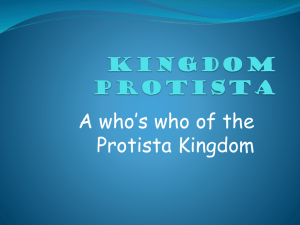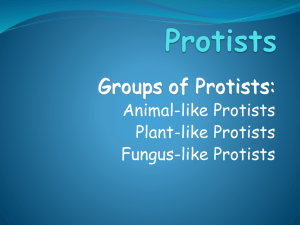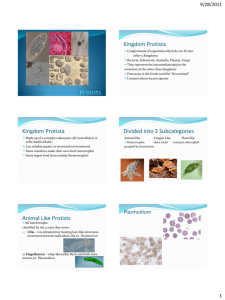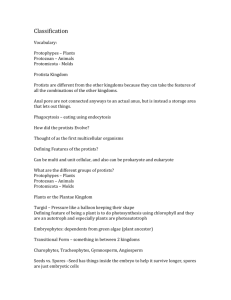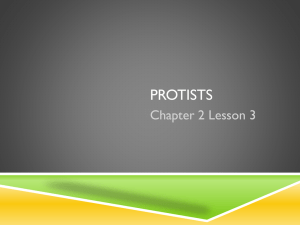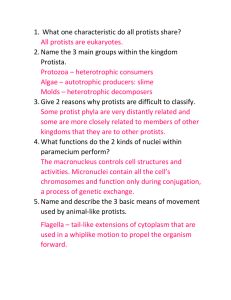real link
advertisement
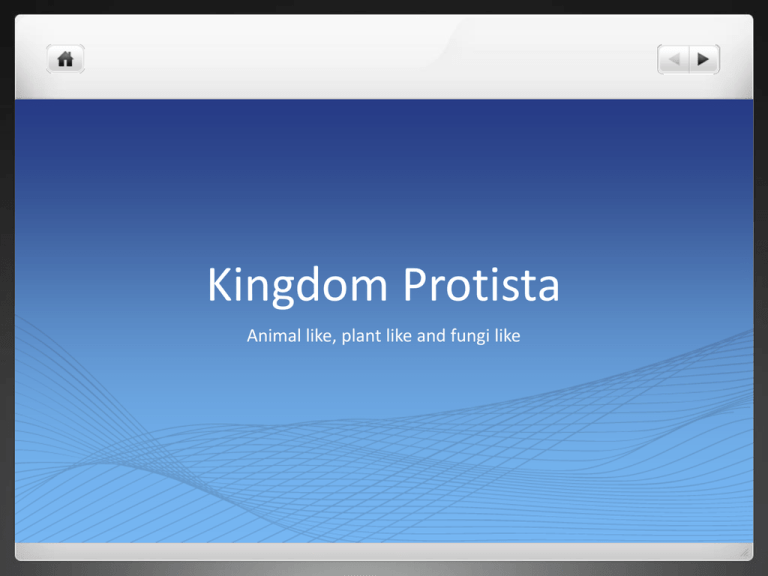
Kingdom Protista Animal like, plant like and fungi like Objectives 1. Define protist. 2. Describe the hypothesis for the origin of eukaryotes. 3. Explain protists classification. 4. Describe two major ways in which protists obtain energy. 5. List three structures protists use for movement. Be prepared to answer questions during the class! What structures and processes protists should have to be able to do this? http://www.youtube.com/watch?v=8Ywgn730Bgw Protista Diverse collection of eukaryotic organisms. Protozoa, algae, slime molds, water molds. Animal- like, plants-like, fungi-like. But they lack the cellular differentiation found in animal, plants and fungi. Protista Single celled or simple multicellular eukaryotic organisms. Generally they don’t fit any other kingdom. Some are microscopic but others like algae can be meters in lenght. Protists emerged early in history and some are the oldest eukaryotes. Brain storm about the size Why you think protists are bigger in size than bacteria? This is a very diverse group in forms and they may be unicellular and multicellular. Nutrition Some are autotrophs and make their own food in a similar way as plants do. Some are heterotrophs and must get their food eating organisms or their byproducts. Others obtain their energy like fungi producing digestive enzymes. Movement Some use flagella to move. Others use cilia (shorter than flagella). Others use pseudopods like amoebas. Animal-like protista Obtain food and move in an animal-like way but they are not closely related. Phylum Protozoa: Move by pseudopoda. Some have their cell membrane directly in contact with the environment while others are covered in calcium carbonate or silicon dioxide. Some live freely while other in human intestines like Entomoeba histolytica. 40,000 species. Phylum Ciliophora: 1-contractile vacuole 2-digestive vacuole 3-macronucleous 4-micronucleous 5-cytoprocto 6-cytopharynx 7-cytostome 8-cilium Move by cilia. Most common species are from the genus Paramecium. The white spot disease in fresh water fish (aquariums) is caused by a parasitic ciliate that lives under the scales. 8,000 species. What structures distinguish an amoeba from a paramecium? Plant-like protist They vary in size from tiny unicellular organisms to multicellular giants (60m). They are autotrophs that use photosynthesis to make their own carbohydrates. Algae They have chlorophyll a like plants. Most are aquatic and at some point have flagella. • • • • Four basic forms of life: Unicellular – free living phytoplankton Colonial – like Volvox Filamentous multicellular – like Spirogyra Multicellular complex algae – like kelps and seaweeds. Examples: What makes them look like plants? Phylum Euglenophyta: Euglenoid Euglena Photosynthetic but move like animals. They lack cell wall. Common in ponds. Have flagella. 1,000 species. Protozoans Protozoan cell What makes this cell eukaryotic? Fungi-like protist Biologists recognize them in two groups; slime molds and water molds. Slime molds live in moist decaying matter and have a two stage life cycle: mobile amoeba like feeding and stationary fungus-like. Water molds are fungus like protist composed of branching filaments found in water bodies but sometimes in soil and as parasites. Protists and humans
